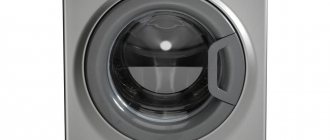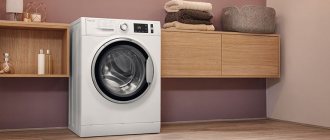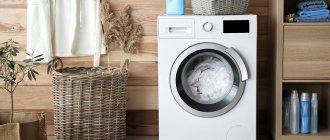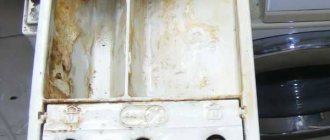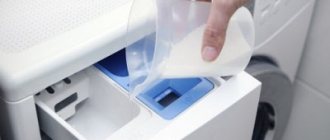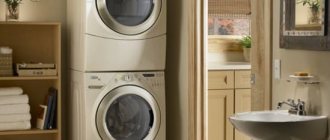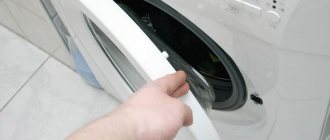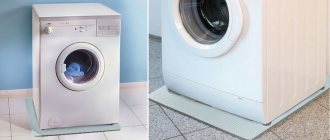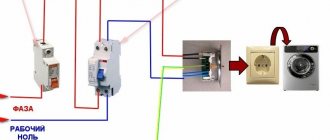How to paint household appliances - refrigerator, washing machine, microwave
1 1 1 1 1 1 1 1 1 1 Rating 5.00 (4 Votes)
| There are situations when an annoying scratch appears on the door of a new refrigerator. Or you bought a new kitchen, and the old silver dishwasher does not fit into the updated color scheme at all. Or maybe there is a young artist in your family who, in a fit of inspiration, painted the microwave with indelible transforming robots? For all such cases, they came up with special paints for household appliances - and we will now tell you how to use them. |
Preparing for work
The very first thing you need to do before painting a piece of household appliance is to decide for what purpose painting is actually required. It's one thing if you just wanted to have an updated refrigerator. It’s completely different if there are deep scratches on the refrigerator through which rust has begun to spread. The work schemes in these cases will differ: in the second case, anti-corrosion cleaning and additional primer for the paint layer will be required.
Article on the topic: How to wash thread curtains in a washing machine
The next important step is choosing the right paint. Today, manufacturers offer many types of paints that are also suitable for painting household appliances. However, the use of universal compositions may not bring the desired result: household appliances are heated and cooled, and are constantly exposed to moisture and detergents - not every paint turns out to be durable enough to maintain a fresh look for a long time in such conditions.
For optimal results, we advise you to choose paints created specifically for household appliances. These are epoxy or acrylic aerosol compositions from the brands Decorix, Kudo, Bosny, Veslee and other manufacturers. High-strength aerosol paints in convenient small cans provide not only a fresh look to household appliances, but also high-quality protection from abrasions, damage and scratches. Also suitable for painting household appliances are paints for metal and paints for plastic in a wide variety of color variations: glossy or matte pure RAL shades, all kinds of metallic colors, paints with mother-of-pearl or hammer effect.
In addition to paint of the desired color and quality, you will need:
•
masking film and tape (to protect handles, rubber seals, panels from unnecessary painting);
•
sandpaper for sanding;
•
solvent and detergents (to clean the surface from accumulated household dirt);
•
primer (for filling scratches and leveling the surface);
•
respirator and gloves to protect yourself from paint.
Article on the topic: Where is the starting capacitor in a washing machine?
Preparing for work
Place the household appliance in a well-lit room, on a flat surface, and unplug it from the power supply. The room must be ventilated. It is important that there is enough space around for normal access to all areas that require painting. Clean all parts from dirt, grease, stickers; Use sandpaper to remove the old enamel layer. Instead of sandpaper, you can use a special paint remover: for example, ABRO aerosol remover effectively removes any type of paint, including from hard-to-reach places. If your refrigerator/washing machine/microwave is new and you just want to paint it or completely change the color, there is no need to remove the enamel.
Assess the surfaces to be painted for cracks, scratches and other damage affecting the metal: if any, carry out anti-corrosion treatment (for example, using a rust converter) and level the damaged areas with primer for painting. You can use separate acrylic primers (MOTiP, Veslee, Bosny), or take the Abro rust converter, which combines the properties of anticorrosive and primer. In addition, some ready-made colored enamels (notably Decorix and Rust-Oleum) also contain rust neutralizers. Pay attention to the color: for white, beige and other light paints it is better to use only white primer; for dark colors, gray and black primers are suitable.
Cover with masking tape or film those parts that do not need to be painted: metal logos and nameplates, locks and rubber seals, control panels, handles and buttons. Do not use ordinary stationery tape for these purposes: its adhesive traces are very difficult to clean off later.
Article on the topic: How to use white in the washing machine
Prepare the required amount of aerosol enamel: usually manufacturers indicate paint consumption based on the area. On average, one small can is enough for 1.5 sq.m. If your household appliances need a fancy multi-colored design, mark the sketch and attach stencils.
Spray paint is applied evenly, from a short distance (30-40 cm). Keep the sprayer lever in one position - then the paint layer will be as uniform as possible. It is important to protect your respiratory system with a respirator: sprayed paint particles are unlikely to be beneficial to your bronchi and lungs, even if the paint has a non-toxic acrylic composition. Manufacturers advise applying paint for household appliances in 1-2 layers. Each layer of applied enamel must be dried - as a rule, modern aerosol enamel dries quickly.
The new look of your household appliances is ready. Carefully remove the protective films and stencils, check the quality and uniformity of the coloring, check the evenness of the lines, and if necessary, correct the flaws with a new layer of enamel. For a more effective result, you can additionally treat the new paint layer with a fixing varnish, which is available in the Bosny and Veslee paint and varnish lines.
Painting household appliances yourself is not very difficult and does not require significant material costs (compared to buying new appliances). In any case, you get not only an updated look and protection from chips and damage, but also a unique color scheme for your refrigerator or washing machine, which depends only on the flight of your imagination.
Article on the topic: How to find out that the washing machine does not heat the water
Visitors to this page most often choose from the online store:
Preparing the surface to be painted
A washing machine whose body is covered with red spots greatly spoils the appearance of the room. Therefore, users are wondering how to return the “home assistant” to its previous appearance? Is it possible to paint over rust on a washing machine? How to perform cosmetic repairs at minimal cost?
First you need to prepare the surface for subsequent painting. The algorithm of actions will be as follows:
- cover with masking tape all areas that can be stained with paint during the process;
- sand the places where the machine is rusty;
- Use a dry cloth to clean off any dust that has settled on the body during the grinding process;
- degrease the areas being prepared for painting. To do this, you will need a special product, for example, NEWTON degreaser;
- Apply zinc primer to the rusted areas. Shake the can and spray the product onto the body at a distance of 20-30 cm from the surface. The primer is applied in a thin layer;
Zinc primer perfectly fights rust and stops corrosive destruction.
- leave the machine for 30-40 minutes so that the composition dries;
- Wipe the body with a dry cloth and remove all dirt from it.
This completes the preparation of the washing machine body for painting. The primer perfectly protects the metal walls of the machine from moisture and prevents further appearance of traces of rust.
How to paint household appliances - refrigerator, washing machine, microwave
1 1 1 1 1 1 1 1 1 1 Rating 5.00 (2 Votes)
| There are situations when an annoying scratch appears on the door of a new refrigerator. Or you bought a new kitchen, and the old silver dishwasher does not fit into the updated color scheme at all. Or maybe there is a young artist in your family who, in a fit of inspiration, painted the microwave with indelible transforming robots? For all such cases, they came up with special paints for household appliances - and we will now tell you how to use them. |
Preparing for work
The very first thing you need to do before painting a piece of household appliance is to decide for what purpose painting is actually required. It's one thing if you just wanted to have an updated refrigerator. It’s completely different if there are deep scratches on the refrigerator through which rust has begun to spread. The work schemes in these cases will differ: in the second case, anti-corrosion cleaning and additional primer for the paint layer will be required.
The next important step is choosing the right paint. Today, manufacturers offer many types of paints that are also suitable for painting household appliances. However, the use of universal compositions may not bring the desired result: household appliances are heated and cooled, and are constantly exposed to moisture and detergents - not every paint turns out to be durable enough to maintain a fresh look for a long time in such conditions. For optimal results, we advise you to choose paints created specifically for household appliances. These are epoxy or acrylic aerosol compositions from the brands Decorix, Kudo, Bosny, Veslee and other manufacturers. High-strength aerosol paints in convenient small cans provide not only a fresh look to household appliances, but also high-quality protection from abrasions, damage and scratches. Also suitable for painting household appliances are paints for metal and paints for plastic in a wide variety of color variations: glossy or matte pure RAL shades, all kinds of metallic colors, paints with mother-of-pearl or hammer effect.
Article on the topic: Is it possible to wash goalkeeper gloves in a washing machine?
In addition to paint of the desired color and quality, you will need: • masking film and tape (to protect handles, rubber seals, panels from unnecessary painting); • sandpaper for sanding; • solvent and detergents (to clean the surface from accumulated household dirt); • primer (for filling scratches and leveling the surface); • respirator and gloves to protect yourself from paint.
Preparing for work
Place the household appliance in a well-lit room, on a flat surface, and unplug it from the power supply. The room must be ventilated. It is important that there is enough space around for normal access to all areas that require painting. Clean all parts from dirt, grease, stickers; Use sandpaper to remove the old enamel layer. Instead of sandpaper, you can use a special paint remover: for example, ABRO aerosol remover effectively removes any type of paint, including from hard-to-reach places. If your refrigerator/washing machine/microwave is new and you just want to paint it or completely change the color, there is no need to remove the enamel.
Assess the surfaces to be painted for cracks, scratches and other damage affecting the metal: if any, carry out anti-corrosion treatment (for example, using a rust converter) and level the damaged areas with primer for painting. You can use separate acrylic primers (MOTiP, Veslee, Bosny), or take the Abro rust converter, which combines the properties of anticorrosive and primer. In addition, some ready-made colored enamels (notably Decorix and Rust-Oleum) also contain rust neutralizers. Pay attention to the color: for white, beige and other light paints it is better to use only white primer; for dark colors, gray and black primers are suitable. Cover with masking tape or film those parts that do not need to be painted: metal logos and nameplates, locks and rubber seals, control panels, handles and buttons. Do not use ordinary stationery tape for these purposes: its adhesive traces are very difficult to clean off later.
Article on the topic: Is it possible to wash an orthopedic pillow in a washing machine?
Prepare the required amount of aerosol enamel: usually manufacturers indicate paint consumption based on the area. On average, one small can is enough for 1.5 sq.m. If your household appliances need a fancy multi-colored design, mark the sketch and attach stencils. Spray paint is applied evenly, from a short distance (30-40 cm). Keep the sprayer lever in one position - then the paint layer will be as uniform as possible. It is important to protect your respiratory system with a respirator: sprayed paint particles are unlikely to be beneficial to your bronchi and lungs, even if the paint has a non-toxic acrylic composition. Manufacturers advise applying paint for household appliances in 1-2 layers. Each layer of applied enamel must be dried - as a rule, modern aerosol enamel dries quickly.
The new look of your household appliances is ready. Carefully remove the protective films and stencils, check the quality and uniformity of the coloring, check the evenness of the lines, and if necessary, correct the flaws with a new layer of enamel. For a more effective result, you can additionally treat the new paint layer with a fixing varnish, which is available in the Bosny and Veslee paint and varnish lines. Painting household appliances yourself is not very difficult and does not require significant material costs (compared to buying new appliances). In any case, you get not only an updated look and protection from chips and damage, but also a unique color scheme for your refrigerator or washing machine, which depends only on the flight of your imagination.
Article on the topic: Ariston washing machine error f-08 what to do
Visitors to this page most often choose from the online store:
Cleaning rust outside
During operation, the question often arises of how to clean rust in a washing machine that has appeared on its external plastic surfaces. Toothpaste can help fight rust. It is applied to the stains and rubbed with a sponge or brush, and then washed with water.
If the paintwork is damaged, as well as if it is necessary to remove traces of corrosion, restoration is necessary. In stores you can buy special white enamel for restoring equipment (in particular washing machines) and zinc primer (preferably in a can).
Work to remove the effects of corrosion is carried out as follows:
- It is necessary to stick a film or masking tape around the surface to be restored to protect the surface around the one being painted;
- Rusty areas of the machine should be cleaned with sandpaper (fine grains) and any rust that is peeling off should be removed;
- Wipe the surface to be treated with a napkin or clean cloth;
- Degrease the surface with a degreaser (for example, “NEWTON”);
- Thoroughly shake the can of primer, spray the primer from a distance of 30 centimeters and leave to dry for half an hour;
- After shaking the can of paint several times, apply enamel from a distance of 30 centimeters to the primed area;
- If necessary, apply a second layer of enamel after 20 minutes and allow to dry completely;
- Remove the protective film and masking tape.
How to prevent rust
If rusty stains appear on the washing machine, this indicates that the water used is not of the best quality. You can’t even do laundry in such water, you can’t even wash dishes. This type of water requires cleaning.
To protect your household appliances, we recommend:
- Purchase special products from stores that sell household chemicals that work well against rust on plastic and metal surfaces.
- Install cleaning filters on the water pipe before entering the machine.
- Do a cold wash with citric acid (without linen and clothes).
- Add a tablespoon of salt to a glass of vinegar and wipe the body of the machine with this mixture. Pour the remaining liquid into the drum, wait 30 minutes and perform a single wash. This will help get rid of scale.
- After each wash, wipe the powder tray and the rubber of the loading hatch dry.
These recommendations should be followed at least once a year, but with caution, since many modern washing machines, especially imported ones, may have parts made of fragile and thin materials.
And under no circumstances should you rub rusted areas with powder - bacteria will grow in the scratches that appear. It wouldn’t be superfluous to tell everyone who uses a washing machine what and how to do to avoid breakdowns.
Cleaning rust inside a washing machine
The internal parts of the washing machine are cleaned with vinegar or citric acid. However, this method is applicable only in case of minor damage. The substance is applied to the rusty areas and after one and a half to two hours is wiped with steel wool.
Article on the topic: Where is inexpensive repair of electrolux washing machines
Baking soda also helps fight corrosion inside the car. It is applied to the rusty areas and after half an hour is wiped with a washcloth and then washed with water. The internal components and parts of the washing machine can also be cleaned using special products, following the instructions.
If the surface of the machine or the washing drum is too rusty, they will have to be replaced. Most often, parts on the rear wall of the unit rust, so if you notice yellowness, it should be removed immediately.
To prevent corrosion from progressing in the future:
- Rusty stains should be washed with special anti-corrosion agents (apply for half an hour and wash off), stain removers;
- Using improvised means such as vinegar, hydrogen peroxide and lemon juice (or citric acid, but diluted in accordance with the instructions), minor yellowed stains are removed in a 1 to 1 ratio. In cases of severe contamination, use a paste of water and soda. After treatment, the surface is wiped with a sponge and washed;
- The part with rust is placed in a container with Coca-Cola carbonated drink - the rust is quickly corroded due to the phosphoric acid it contains.
If these measures are not taken, corrosion will continue, which will lead to complete failure of the device.
Why does a car rust?
Often, after rust appears on a washing machine, the owners do not even try to change the operating conditions of the unit and continue to use the machine in the same room and under the same conditions that caused the problem.
If the lid of the washing machine is rusty, this means that there is high humidity in the room. If you reduce it to normal, the cause of rust will disappear. When rust appears on the metal parts of the washing machine, the owner can independently understand the reason; he just needs to pay attention to where the excess moisture may be coming from.
Therefore, you should know that it is not recommended to use the washing machine in places where there are open water tanks, as well as in rooms where it is constantly too humid or where steam or condensation periodically appears.
